Alan Marshall
Perceptions of Edinburgh: Capturing Neighbourhood Characteristics by Clustering Geoparsed Local News
Sep 17, 2024



Abstract:The communities that we live in affect our health in ways that are complex and hard to define. Moreover, our understanding of the place-based processes affecting health and inequalities is limited. This undermines the development of robust policy interventions to improve local health and well-being. News media provides social and community information that may be useful in health studies. Here we propose a methodology for characterising neighbourhoods by using local news articles. More specifically, we show how we can use Natural Language Processing (NLP) to unlock further information about neighbourhoods by analysing, geoparsing and clustering news articles. Our work is novel because we combine street-level geoparsing tailored to the locality with clustering of full news articles, enabling a more detailed examination of neighbourhood characteristics. We evaluate our outputs and show via a confluence of evidence, both from a qualitative and a quantitative perspective, that the themes we extract from news articles are sensible and reflect many characteristics of the real world. This is significant because it allows us to better understand the effects of neighbourhoods on health. Our findings on neighbourhood characterisation using news data will support a new generation of place-based research which examines a wider set of spatial processes and how they affect health, enabling new epidemiological research.
Towards Length-Versatile and Noise-Robust Radio Frequency Fingerprint Identification
Jul 06, 2022



Abstract:Radio frequency fingerprint identification (RFFI) can classify wireless devices by analyzing the signal distortions caused by the intrinsic hardware impairments. State-of-the-art neural networks have been adopted for RFFI. However, many neural networks, e.g., multilayer perceptron (MLP) and convolutional neural network (CNN), require fixed-size input data. In addition, many IoT devices work in low signal-to-noise ratio (SNR) scenarios but the RFFI performance in such scenarios is rarely investigated. In this paper, we analyze the reason why MLP- and CNN-based RFFI systems are constrained by the input size. To overcome this, we propose four neural networks that can process signals of variable lengths, namely flatten-free CNN, long short-term memory (LSTM) network, gated recurrent unit (GRU) network and transformer. We adopt data augmentation during training which can significantly improve the model's robustness to noise. We compare two augmentation schemes, namely offline and online augmentation. The results show the online one performs better. During the inference, a multi-packet inference approach is further leveraged to improve the classification accuracy in low SNR scenarios. We take LoRa as a case study and evaluate the system by classifying 10 commercial-off-the-shelf LoRa devices in various SNR conditions. The online augmentation can boost the low-SNR classification accuracy by up to 50% and the multi-packet inference approach can further increase the accuracy by over 20%.
Towards Receiver-Agnostic and Collaborative Radio Frequency Fingerprint Identification
Jul 06, 2022



Abstract:Radio frequency fingerprint identification (RFFI) is an emerging device authentication technique, which exploits the hardware characteristics of the RF front-end as device identifiers. RFFI is implemented in the wireless receiver and acts to extract the transmitter impairments and then perform classification. The receiver hardware impairments will actually interfere with the feature extraction process, but its effect and mitigation have not been comprehensively studied. In this paper, we propose a receiver-agnostic RFFI system that is not sensitive to the changes in receiver characteristics; it is implemented by employing adversarial training to learn the receiver-independent features. Moreover, when there are multiple receivers, this functionality can perform collaborative inference to enhance classification accuracy. Finally, we show how it is possible to leverage fine-tuning for further improvement with fewer collected signals. To validate the approach, we have conducted extensive experimental evaluation by applying the approach to a LoRaWAN case study involving ten LoRa devices and 20 software-defined radio (SDR) receivers. The results show that receiver-agnostic training enables the trained neural network to become robust to changes in receiver characteristics. The collaborative inference improves classification accuracy by up to 20% beyond a single-receiver RFFI system and fine-tuning can bring a 40% improvement for under-performing receivers.
Radio Frequency Fingerprint Identification for Security in Low-Cost IoT Devices
Nov 28, 2021
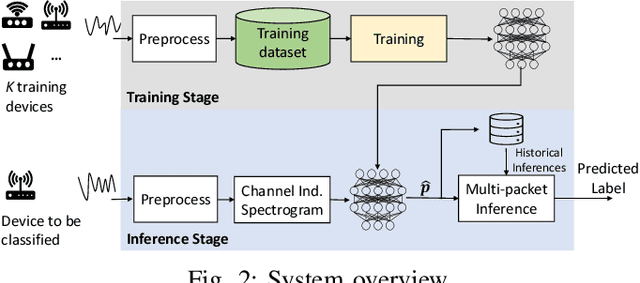
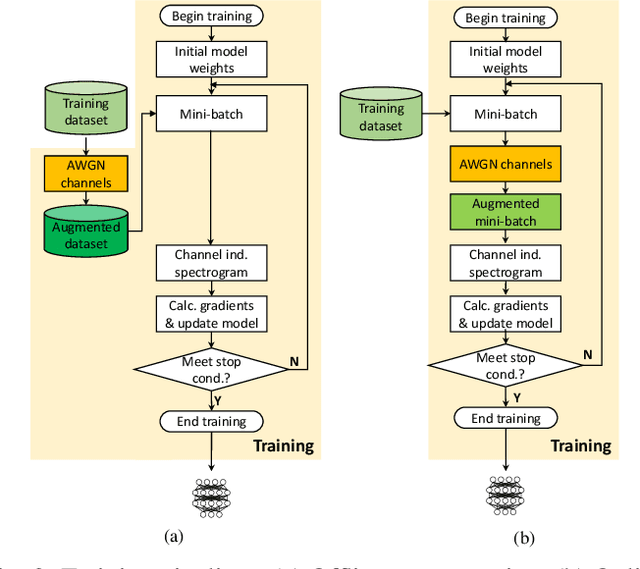
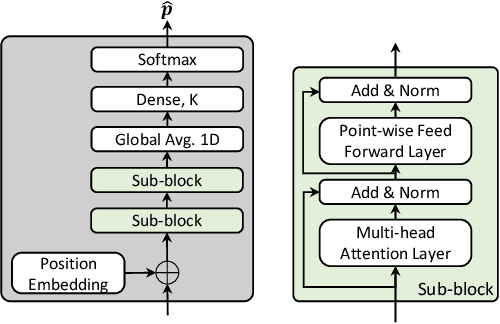
Abstract:Radio frequency fingerprint identification (RFFI) can uniquely classify wireless devices by analyzing the received signal distortions caused by the intrinsic hardware impairments. The state-of-the-art deep learning techniques such as convolutional neural network (CNN) have been adopted to classify IoT devices with high accuracy. However, deep learning-based RFFI requires input data of a fixed size. In addition, many IoT devices work in low signal-to-noise ratio (SNR) scenarios but the low SNR RFFI is rarely investigated. In this paper, the state-of-the-art transformer model is used as the classifier, which can process signals of variable length. Data augmentation is adopted to improve low SNR RFFI performance. A multi-packet inference approach is further proposed to improve the classification accuracy in low SNR scenarios. We take LoRa as a case study and evaluate the system by classifying 10 commercial-off-the-shelf LoRa devices in various SNR conditions. The online augmentation can boost the low SNR RFFI performance by up to 50% and multi-packet inference can further increase it by over 20%.
Towards Scalable and Channel-Robust Radio Frequency Fingerprint Identification for LoRa
Jul 06, 2021Abstract:Radio frequency fingerprint identification (RFFI) is a promising device authentication technique based on the transmitter hardware impairments. In this paper, we propose a scalable and robust RFFI framework achieved by deep learning powered radio frequency fingerprint (RFF) extractor. Specifically, we leverage the deep metric learning to train an RFF extractor, which has excellent generalization ability and can extract RFFs from previously unseen devices. Any devices can be enrolled via the pre-trained RFF extractor and the RFF database can be maintained efficiently for allowing devices to join and leave. Wireless channel impacts the RFF extraction and is tackled by exploiting channel independent feature and data augmentation. We carried out extensive experimental evaluation involving 60 commercial off-the-shelf LoRa devices and a USRP N210 software defined radio platform. The results have successfully demonstrated that our framework can achieve excellent generalization abilities for device classification and rogue device detection as well as effective channel mitigation.
Radio Frequency Fingerprint Identification for LoRa Using Spectrogram and CNN
Dec 30, 2020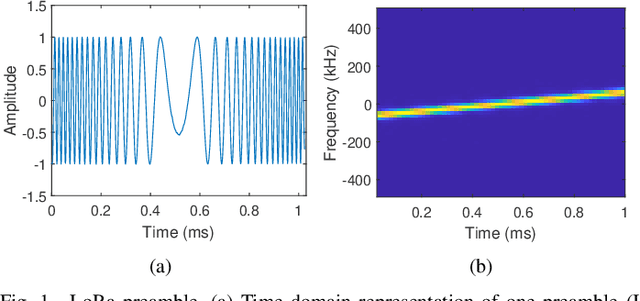
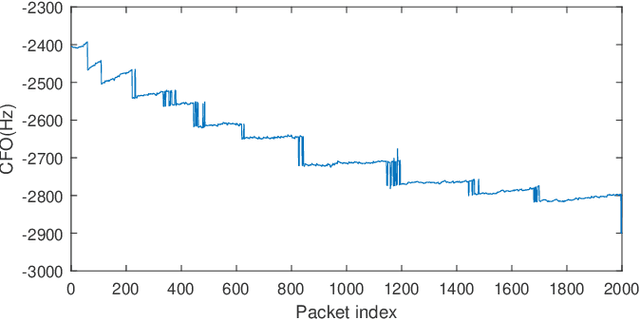
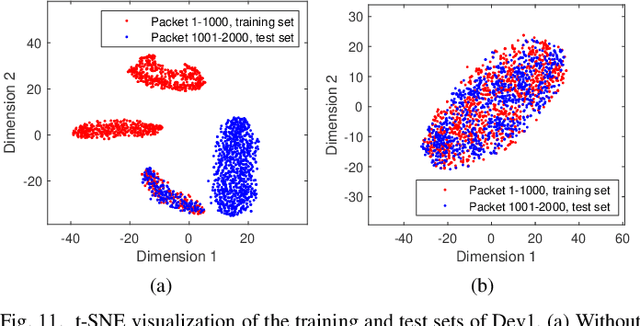
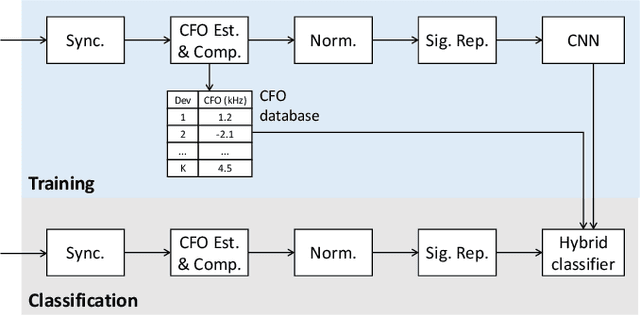
Abstract:Radio frequency fingerprint identification (RFFI) is an emerging device authentication technique that relies on intrinsic hardware characteristics of wireless devices. We designed an RFFI scheme for Long Range (LoRa) systems based on spectrogram and convolutional neural network (CNN). Specifically, we used spectrogram to represent the fine-grained time-frequency characteristics of LoRa signals. In addition, we revealed that the instantaneous carrier frequency offset (CFO) is drifting, which will result in misclassification and significantly compromise the system stability; we demonstrated CFO compensation is an effective mitigation. Finally, we designed a hybrid classifier that can adjust CNN outputs with the estimated CFO. The mean value of CFO remains relatively stable, hence it can be used to rule out CNN predictions whose estimated CFO falls out of the range. We performed experiments in real wireless environments using 20 LoRa devices under test (DUTs) and a Universal Software Radio Peripheral (USRP) N210 receiver. By comparing with the IQ-based and FFT-based RFFI schemes, our spectrogram-based scheme can reach the best classification accuracy, i.e., 97.61% for 20 LoRa DUTs.
 Add to Chrome
Add to Chrome Add to Firefox
Add to Firefox Add to Edge
Add to Edge